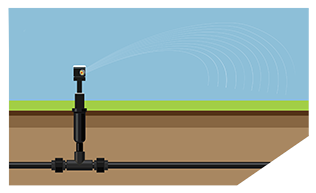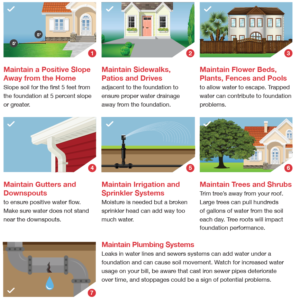Is There Anything I can do to Prevent Foundation Problems?

As the soil under a house shrinks and swells with the seasons, the house and foundation will move up and down. As long as the foundation movement is not great enough to damage the house and/or foundation, most people do not consider the movement to be a foundation repair problem. If the up and down movement of a house foundation always returns the house foundation to its original level position, then damage to the house and foundation may appear and disappear on a regular basis as the seasons change.
If a homeowner wishes to stop seasonal house and foundation damage, the first course of action should be to follow a controlled watering program. By keeping the moisture content of the soil under the house foundation constant, foundation movement can often be stopped. This has been written to assist the homeowner in performing a simple foundation repair preventive maintenance program.

Click here to view and download our handy Foundation Maintenance Guide
The goal of a foundation repair preventive maintenance watering program is to maintain a constant level of moisture in the soil under the house and foundation. The best way to water a foundation is to place a soaker hose from one to two feet from the edge of the foundation. Placing the hose a short distance from the foundation allows the water to soak into the soil evenly.
The hose should not be placed against the foundation. When soil has dried and cracked, water can travel along the cracks for several feet in all directions. If the soil around your foundation is dried and cracked, then water placed next to the foundation will run through the cracks and accumulate at the bottom of the grade beam (the thick portion of the foundation that is under the exterior walls). In some cases, an accumulation of water in the soil at the base of a foundation can cause the soil to lose some of its load-bearing capacity. If the soil loses enough load-bearing capacity, the house will sink into the ground.
Obviously, it is necessary to water more during hot, dry weather and less during cold, damp weather. The amount of water required to keep a foundation stable during the summer can be surprisingly large. A single large tree can remove as much as 150 gallons of water, or almost 20 cubic feet of water, from the soil each day. Shrubs and other plants can also remove large quantities of water.
During persistent hot dry weather, it may be necessary to water a foundation daily. Watering should supply enough water to keep the moisture content in the soil under the foundation constant. If the amount of water applied is only enough to keep the surface damp, the watering program will not work. Obviously, the homeowner is the only one who can weigh the benefits of controlling foundation movement versus the increased size of the water bill.
For more information, download our Foundation Maintenance Guide.
FAQ About Foundation Repair & Olshan Services
How much do you charge for an estimate?
Olshan always provides foundation inspections to homeowners at no charge. Contact us today for your free estimate!
How much do you charge for your services?
Olshan always offers a free estimate to homeowners. When our trained technician comes to your home we will provide a complete analysis and honest evaluation. If repairs are needed, we will provide a cost-effective solution designed uniquely for your home.
Why is the Cable Lock™ ST System the most preferred method of foundation repair?
The Cable Lock™ ST System combines the penetrating power of steel with the longevity and bearing capability of concrete; providing a deeper, stronger, and more reliable foundation repair. That’s why we offer an Available Lifetime Transferable Warranty as well as other warranty options to meet your needs.
Do you provide references?
Olshan helps more than 10,000 homeowners each year. We would be proud to provide you a list of homes we have repaired in your area.
Are you a member of any trade organizations?
Olshan is proud to be a nationwide member of the BBB. We are also members of the Foundation Repair Association, the National Association of Waterproofing and Structural Repair Contractors, the Basement Health Organization and other local organizations.
I am selling a home with a warranty from Olshan, how can I transfer it?
Your transferable warranty from Olshan Foundation Solutions can be passed onto subsequent owners of your property. Simply complete the Warranty Transfer Form, pay the transfer fee and return the paperwork to Olshan within 90 days of the sale of the property to initiate the transfer process. It’s that easy!
When you sell the property it is important to provide the new buyer with (1) a copy of the original contract, (2) the drawing showing the area repaired, (3) the warranty, and (4) a warranty transfer form.
If you lose your documents, please contact us for a replacement. It is important to notify the buyer of repairs performed on the property and include the conditions of warranty transfer as part of your Seller’s Disclosure.
What’s the difference between helical piers and Cable Lock ST Plus?
Helical piers and Cable Lock ST Plus are both types of foundation repair systems that are used to stabilize and lift a sinking or settling foundation. However, there are some key differences between the two systems.
Helical piers are long, steel shafts with helix-shaped plates (or “blades”) that are screwed into the ground using a hydraulic torque motor. They are typically used to stabilize foundations that are built on unstable soil or to lift foundations that have settled. Helical piers are installed by drilling a hole in the ground and then screwing the pier into the soil.
Cable Lock ST Plus, on the other hand, is a newer system that is used to repair and stabilize foundations. It is a galvanized steel bracket that is anchored to the foundation and to the soil. The bracket is connected to a steel cable that is tensioned to lift the foundation back to its original level. This system is typically used for foundations that have settled or are showing signs of cracking or bowing.
In short, helical piers are screwed into the ground to provide support and stability to the foundation, while Cable Lock ST Plus is a bracket and cable system that is anchored to the foundation and to the soil to lift and stabilize it.
